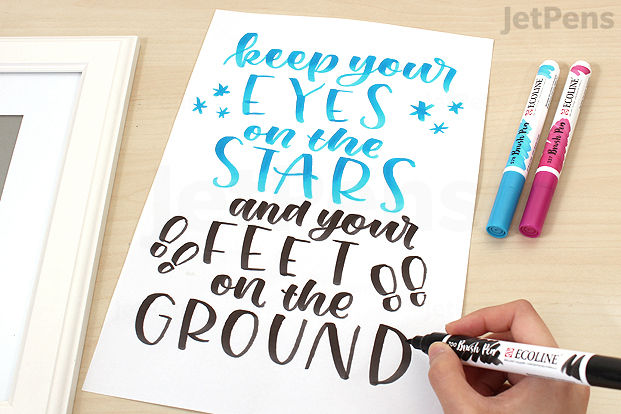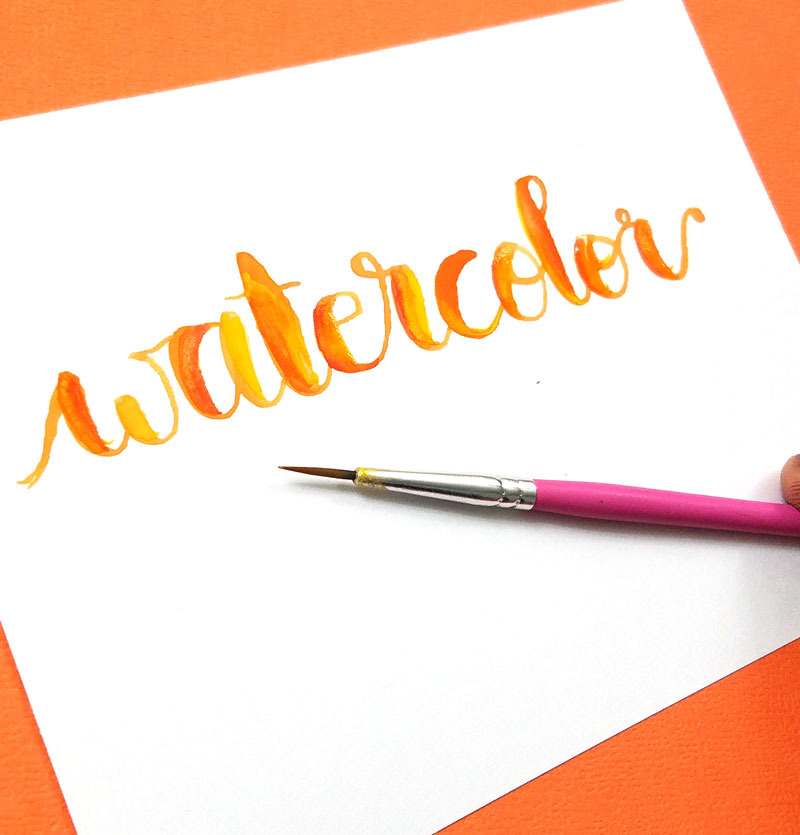

Rick Harris is one of the best pinstripers working today. He can production stripe factory cars, He’s striped custom electric guitars for Gibson, he’s hand lettered and striped NASCAR race cars, and more. Over 2 years in the Gibson factory he striped over 1000 custom Les Paul guitars. Back in the 90s when the American car companies had a big problem with delaminating paint, he was one of the guys who tasked with repainting the factory pinstripes perfectly. He came in to the studio and did a live how-to demo with Kevin.
Mack brushes are the standard of the industry and still made in Michigan. They consist of a short handle, the hair, and a ferrule to hold them together. They only work in one direction, so there is a bump in the ferrule that should always be on the right side when you hold it. When held properly the hair, which has a straight edge and a curved edge, will have the curved edge on the bottom.
Lettering Brushes Best Selling Lettering Brushes. Redesigned to meet the standards of our other Masterstroke brushes, this professional. Highliner and Outliner Lettering Brushes. Item #: 05536 Extremely long-haired brushes with square tips, for striping. One-Stroke Lettering Brushes. In my shop you can find both my favorite round paint brushes, and my favorite filbert tip paint brush set in a range of sizes. I also have a small assorted pack of paint brushes with both round tip and filbert brushes if you’d like to try starting with just a few of each type of brush for hand lettering.
Eastwood also sells Kafka brushes, created to the specifications of another of the current masters of hand striping, Steve Kafka. These brushes are a little different than the traditional style designs that Mac sells. They were designed with an emphasis on making it easier to turn corners and less likely to flare out and make a wider line. They are designed to be longer lasting and most use a combination of natural and synthetic hairs.
There are different lengths and thicknesses of brush available from both manufacturers. Of course, a thicker brush makes a thicker line. A longer brush, like a longer wheelbase car, is better for going in a straight line. A short brush is much better for making tight corners and scrolls. With a little practice you’ll know how straight or tight you can stripe with a given brush

What is brush lettering? Let’s define “brush lettering” by breaking it apart into the two words: “brush”.
Most pinstriping/sign painting brushes are made out of squirrel hair. Squirrel hair is very fine and flexible, and it holds a lot of paint. There are new synthetic hair brushes available, but they don’t hold as much paint, and they don’t flow as well as the traditional natural hair versions. Kafka’s brushes typically use a proprietary blend of natural and synthetic fibers to provide the stiffness and flow he wanted.
Brushes should be looked at as a consumable, if you are going to do good quality stripes. Once a few hairs fall out, more will start to fall out and more often, just like on your head. Just pick them off the stripes before the paint can dry, or leave them as a sign that this was a real hand painted stripe. In the hands of a man who does a lot of striping like Rick, a bush will be done after just a few weeks of continuous usage. If he can continue to use the same brush for a month, he lucked into a very good brush.
Not quite a brush, but more of a roller, is the Beugler Wheel is sometimes called the “cheater stripe”. It consists of a small container that you fill with paint, a wheel that rolls the paint out in a measured amount as you go. There is no shame in using one of these tools, and often times they are used when applying traditional stripes down the length of a car, or along the rails of a boat trailer. They are very good at putting down long, consistent, straight stipes, but not very good if you have to make sharp bends.
You fill the back of the Beugler with paint and use the plunger to pressurize it slightly. Then it is just a matter of rolling out a line of paint, or 2, or 3, with one of the attachments. The Beugler even has an adjustable guide arm that you can use to follow body lines and edges. For laying down stripes where there is no guide line, Eastwood sells rolls of flexible magnetic edge which stick to the side of the vehicle.
The brush is just one third of the striping equation though, you also need the right paint, and the right technique. Read on the next few blog posts for some helpful advice in those areas.
Brush lettering has become super popular lately due to the interest in Modern Calligraphy styles of writing. Even traditional signwriting has become cool again which I love! In this technologically driven world more businesses are wanting to show authenticity in their brand and are using 'hand made' techniques like hand lettering to do so.
Brush lettering is essentially using a paint brush to write letters. It may sound simple but don't expect to just pick up a brush and be able to write perfectly straight away. There are many skills you need to learn to get the results you want to see from the brush. Similarly to calligraphy there are also two types of brushes - pointed and flat. Each brush creates different lettering looks and is controlled in different ways. I'm also going to introduce you to some modern 'paintbrush' products which make brush lettering even easier.
Actual paint brushes are the most obvious and traditional brushes used to create brush lettering. There are many different brands and types of brushes of which I am yet to master. Admittedly paint brushes are the brush tool I use least, mainly because there are so many options at art stores that I get overwhelmed and don't know which one to choose. I've just started some flat brush lessons though which are really fun and have encouraged me to become more confident when using them.
Taking care of your brushes is very important as the best quality ones can be quite expensive to buy. You have to be very careful not to mess with the shape of the bristles as it will make it extremely hard to make nice letters. Don't let the brush get squished, frayed or clogged up with paint! All calligraphy alphabets can be mimicked using a brush. Pointed brushes are used to create pointed pen letters and flat brushes are best for broad nib letters. Each type is used in a similar way to its calligraphic counterpart. You can get long or short handled brushes but I find short handled brushes are easier to control.
Brush pens are essentially a paint brush combined with a pen. The best advantage of using a brush pen is that you don't have to dip your brush into ink all of the time - it's a lot quicker to use! Brush pens only come with a pointed brush tip and you use it like a pointed pen nib, applying more pressure on downstrokes to get the thicker lines. You will find that some brush pens are refillable which is a lot more economical. Only some brush pen styles will come in a variety of colours (but you will have to buy one of each colour you like) and some even have glitter mixed in with the ink to add an extra shimmer to your writing.
Over the past couple of years I have seen, bought and tried numerous brush pens and they vary a lot! The main differences are in flexibilty, colour and size. I found that a lot weren't great so when you find one that works for you keep using it! My favourites are the Pentel Pocket Brush Pen (GFKP) for larger letters and the Tombow Fudenosuke Brush Pen - Soft for smaller letters.
Waterbrushes are an awesome recent invention from Japan. They were originally designed to use with watercolour pencils whereby you fill the pen with water and brush it over the pencil colouring to create a watercolour artwork. However they also work really well for brush lettering. You can either keep the brush filled with water and dip it into ink or onto a watercolour palette or I have even just straight up filled the brush with ink.
The brush has synthetic bristles which makes it very durable. I've had mine for a while now and the brush tip is still in perfect shape. They are also great for travelling with. I own two different waterbrushes, the Pentel Aquash Water Brush - Medium and the Kuretake Water Brush - Small Compact Size. There's only one reason why I prefer the Pentel brush - it's easier to fill up. Waterbrushes are best when being used for watercolour brush lettering.


Best Paint Brush For Hand Lettering
One of the main reasons I love brush lettering is that the final lettering shapes are quite unpredictable. I enjoy embracing imperfections in my work as that's what makes each letter unique! You can also get some very expressive results, especially when you are working with a drier brush. Have fun exploring different alphabets and make sure you try inventing your own lettering styles!
